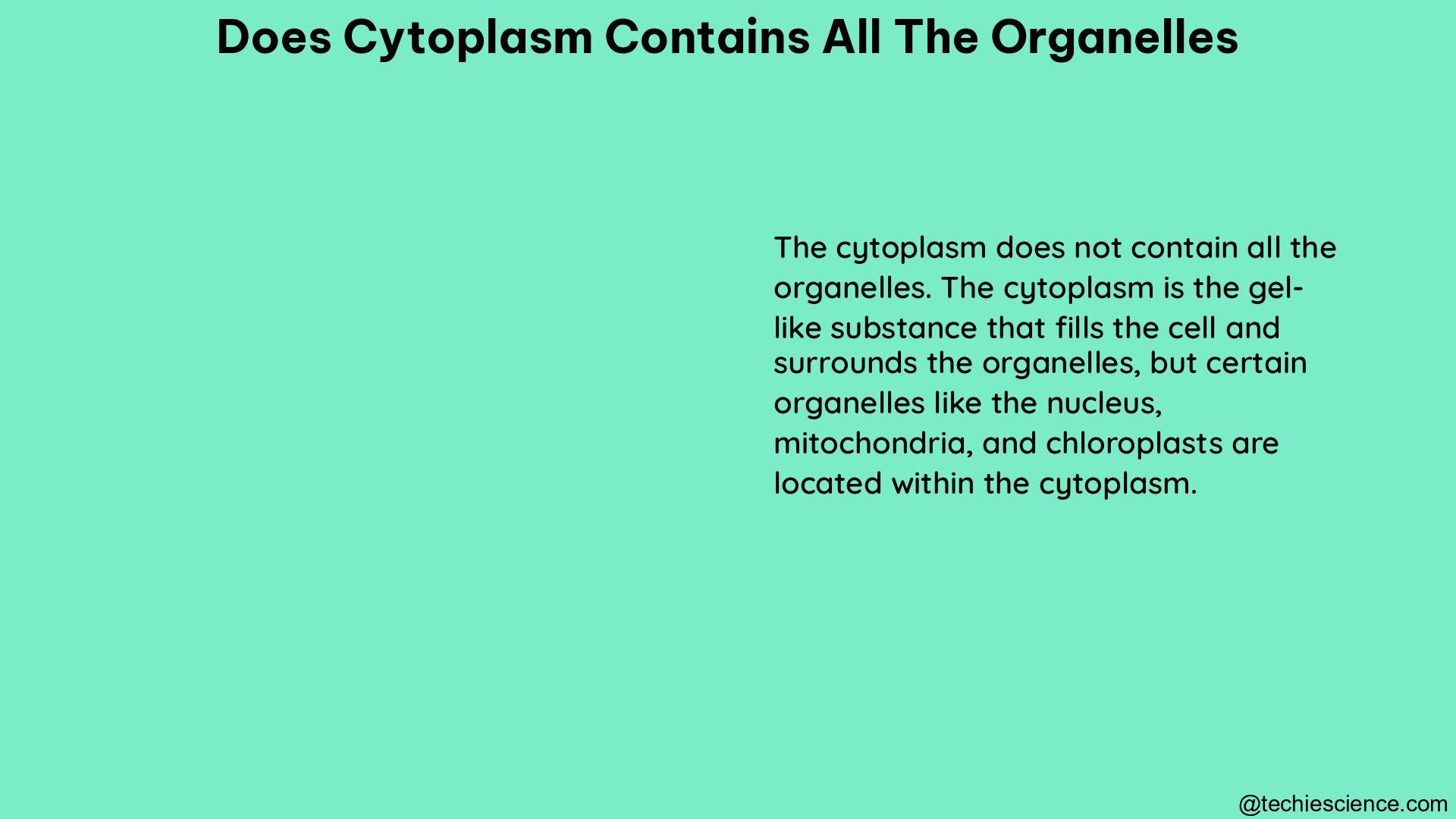The cytoplasm is a crucial component of a cell, filling the space between the cell membrane and the nucleus. It is a gel-like substance primarily composed of water, salts, and proteins. However, the question of whether the cytoplasm contains all the organelles is a matter of semantics and context.
Understanding the Cytoplasm and Its Components
The cytoplasm includes all the material inside the cell but outside the nucleus, which contains its own watery substance called nucleoplasm. According to the Biology LibreTexts, all the organelles in eukaryotic cells, such as the endoplasmic reticulum and mitochondria, are located in the cytoplasm. This definition suggests that the cytoplasm does contain all the organelles.
Organelles in the Cytoplasm
The cytoplasm is the site where various organelles are found, each with its own specialized function. These organelles include:
- Mitochondria: The powerhouses of the cell, responsible for generating energy through the process of cellular respiration.
- Endoplasmic Reticulum (ER): A network of interconnected tubules and sacs that play a crucial role in the synthesis, folding, and transport of proteins.
- Golgi Apparatus: Responsible for the processing, packaging, and distribution of proteins and other molecules within the cell.
- Lysosomes: Membrane-bound organelles that contain digestive enzymes, responsible for breaking down and recycling cellular waste and damaged organelles.
- Peroxisomes: Organelles that contain enzymes involved in the breakdown of fatty acids and the detoxification of various substances.
- Ribosomes: Small organelles responsible for the synthesis of proteins, found either freely in the cytoplasm or attached to the ER.
- Cytoskeleton: A network of protein filaments that provide structural support, shape, and movement to the cell.
Cytoplasm vs. Cytosol
However, other sources suggest that the cytoplasm excludes the organelles. The Biology Stack Exchange discussion indicates that some definitions of cytoplasm exclude organelles, while others include them. The discussion suggests that the distinction between cytoplasm and cytosol (the liquid part of the cytoplasm) can be useful in clarifying whether organelles are included or excluded.
In this context, the cytoplasm would include the organelles, while the cytosol would exclude them. The cytosol is the fluid portion of the cytoplasm, which is a complex mixture of water, salts, and various dissolved molecules, including proteins, lipids, and carbohydrates.
The Importance of Cytoplasm in Cell Function

Regardless of whether the organelles are considered part of the cytoplasm or not, the cytoplasm is a crucial component of the cell that provides a site for various metabolic activities. The cytoplasm serves as the medium for the transport of molecules, the exchange of materials between organelles, and the overall coordination of cellular processes.
Cytoplasmic Streaming
One of the important functions of the cytoplasm is cytoplasmic streaming, which is the movement of the cytoplasm within the cell. This movement helps to distribute nutrients, organelles, and other cellular components throughout the cell, facilitating efficient communication and coordination between different parts of the cell.
Cytoplasmic Matrix
The cytoplasmic matrix, also known as the cytosol, is the liquid portion of the cytoplasm that surrounds the organelles. This matrix is a complex mixture of water, ions, and a variety of dissolved molecules, including proteins, lipids, and carbohydrates. The cytoplasmic matrix provides the necessary environment for the various chemical reactions and metabolic processes that occur within the cell.
Cytoplasmic Inclusions
In addition to the organelles, the cytoplasm may also contain various cytoplasmic inclusions, which are non-living structures that serve specific functions within the cell. These inclusions can include:
- Glycogen granules: Stores of carbohydrates that can be used as an energy source.
- Lipid droplets: Stores of lipids, which can be used for energy or as structural components of the cell.
- Pigment granules: Responsible for the coloration of certain cells, such as in the skin or eyes.
- Crystalline inclusions: Solid, crystalline structures that may serve as storage or structural components.
Conclusion
In summary, the question of whether the cytoplasm contains all the organelles is a matter of definition and context. Some definitions include the organelles as part of the cytoplasm, while others exclude them, referring to the cytosol as the liquid portion of the cytoplasm that excludes the organelles. Regardless of the specific definition, the cytoplasm is a crucial component of the cell that provides the necessary environment and support for various cellular processes and functions.
References:
- Does the cytoplasm include the organelles? – Biology Stack Exchange. https://biology.stackexchange.com/questions/103231/does-the-cytoplasm-include-the-organelles
- What is the main component of the cytoplasm? – Homework.Study.com. https://homework.study.com/explanation/what-is-the-main-component-of-the-cytoplasm.html
- 5.5: Cytoplasm and Cytoskeleton – Biology LibreTexts. https://bio.libretexts.org/Bookshelves/Human_Biology/Human_Biology_%28Wakim_and_Grewal%29/05:_Cells/5.05:_Cytoplasm_and_Cytoskeleton
- Cytoplasm | Definition & Function – Britannica. https://www.britannica.com/science/cytoplasm

Hi…I am Sadiqua Noor, done Postgraduation in Biotechnology, my area of interest is molecular biology and genetics, apart from these I have a keen interest in scientific article writing in simpler words so that the people from non-science backgrounds can also understand the beauty and gifts of science. I have 5 years of experience as a tutor.
Let’s connect through LinkedIn-